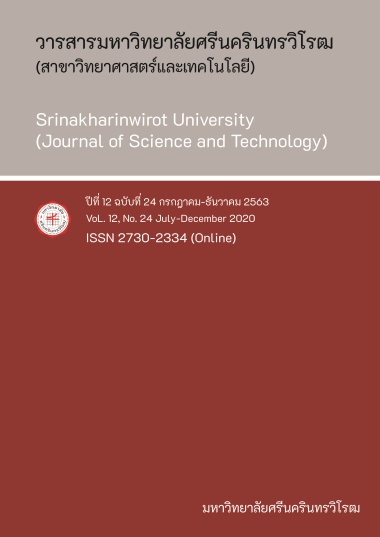จุลินทรีย์ในดินที่มีฤทธิ์ยับยั้งเชื้อรา Curvularia sp. สาเหตุโรคเมล็ดด่างในข้าว SOIL MICROORGANISMS AND THEIR INHIBITION ON CURVULARIA SP.; FUNGAL PATHOGENS USING DIRTY PANICLE DISEASE IN RICE SEED
Keywords:
Mold, Actinomycetes, Curvularia sp., Rice dirty panicle diseaseAbstract
This study aimed to isolate actinomycetes and molds from soil for inhibiting Curvularia sp., a seed-borne pathogen of rice dirty panicle disease. Soil samples were collected from 10 agricultural areas included Tha Sao sub-district of Kanchanaburi Province, Prongmadua and Thungkraphanghom sub-district of Nakhon Pathom Province and Wangwa sub-district of Suphanburi Province. Total 50 actinimycetes were isolated and tested for their antifungal activity against Curvularia sp. by dual culture technique. Following antifungal activity testing, nine isolates exhibited inhibition against Curvularia sp., in which isolate CS40 showed the highest antifungal activity with 72.00% followed by isolate CS43 with 69.00% and isolate CS47 with 63.00%, respectively. Whereas 6 isolates had moderate to low antifungal activities. Only 6 isolates of molds, in which isolate SM05 and SF03 showed the highest antifungal activity with 75.00% followed by isolate SF06, SY02, SF02 and SL03 with 70%, 70%, 67.50% and 62.50%, respectively. Whereas 36 isolates had moderate to low antifungal activities.
Downloads
References
[2] Malichon, K. (2012). Diversity of soil antibacterial activity. Full research reports. Biology Faculty of Science Udon Thani Rajabhat University. pp. 1-82.
[3] Mew, T.W., & Misra, J. K. (1994). A Manual of Rice Seed Health Testing. International Rice Research Institute, Manila, The Phillippines. p. 113.
[4] Gamliel, A., Katan, J., & Cohen, E. (1989). Toxicity of chlornitrobenzenes to Fusarium oxysporum and Rhizoctonia solani as related to their structure. Phytoparasitica, 17, 101-105.
[5] Motreepukdee, R., & Nalumpang, S. (2016, May-August). Efficiency of actinomyceste for controlling Fusarium oxysporum f.sp. lycopersici. Thai Agricultural Research Journal, 34(2), 184-195.
[6] Suanmali, W., & Moonmuan, S. (2017, July-December). The study of bacteria, fungi and actinobacteria grown in soil banana (Musa (AA)) at Sakaew subdistrict, Mueang district, Kamphaeng Phet provice. Science and Technology Journal, 4(2), 71-77.
[7] Thongbansai, P., Thongkamngam, T., & Jaenaksorn, T. (2016). Study on Antagonistic Activity of Trichoderma sp. for controlling Curvularia lunata the causal agent of dirty panicle in rice (Oryza sativa L.). Agricultural Science Journal, 47(3)(Suppl.), 59-62.
[8] Detraksa, J., & Surawattanakij, S. (2018). Isolation of actinomycetes with inhibitory activity against Curvularia lunata causing dirty panicle disease in rice. Agricultural Science Journal, 49(2) (Suppl.), 201-204.
[9] Benitez, T., M.A. Rincon, M.C. Limon, & C.A. Codon. (2004, December). Biocontrol mechanisms of Trichoderma strains. International microbiology, 7(4), 249-260
[10] Pattanapipatphisan, P., & Nawapit, C. (2012, January - March). Biocontrol of Sclerotium rolfsii root and stem rot disease of chili using chitinase-producing actinomycetes, Streptomyces hygroscopicus PACCH24. Science and Technology Ubon Ratchathani University Journal, 14(1), 10-22.
Downloads
Published
How to Cite
Issue
Section
License
Srinakharinwirot University Journal of Sciences and Technology is licensed Under a Creative Commons Attribution-NonCommercial-NoDerivs 4.0 International (CC-BY-NC-ND 4.0) License, Unless Otherwise Stated. Please Read Journal Policies Page for More Information on Open Access, Copyright and Permissions.



